|
Published
monthly for CC employees by Clinical Center Communications
November 1998
Clinpath resource
center
Mercury reduction
Flu shots
NIH Research
Festival
Diversity
issues
CFC Campaign
Rehab Medicine
educates
Balancing
needs
Father Linehan
retires
Getting around
campus
Disability
Awareness
News briefs
|
|
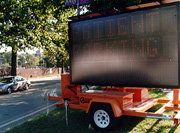 As construction continues to close roads
surrounding the Clinical Center, electronic signs have sprung
up around campus to guide patients to the P3-level parking lots.
Mobile signs such as this one near Center and Convent Drives
use solar power and can quickly be edited to include up-to-the-minute
road changes. To find out more about getting around campus, see
NIH gets around. As construction continues to close roads
surrounding the Clinical Center, electronic signs have sprung
up around campus to guide patients to the P3-level parking lots.
Mobile signs such as this one near Center and Convent Drives
use solar power and can quickly be edited to include up-to-the-minute
road changes. To find out more about getting around campus, see
NIH gets around.
Clinpath provides resource center to NIH community
The Clinical Pathology Department now serves as the umbrella
for NIH laboratories seeking review and compliance with the Clinical
Laboratory Improvement Amendment (CLIA).
"The NIH community is conducting some excellent research
and we see this resource center as an opportunity to help increase
investigators' understanding of the requirements of CLIA,"
said Dr. Thomas Fleisher, chief of Clinical Pathology. "Our
role is to provide them with information and help them to be
successful in the CLIA process."
The Clinical Laboratory Improvement Act of 1967 was passed
in an effort to regulate laboratory testing in the U.S. The law
was amended in 1988 to expand federal oversight to virtually
all clinical laboratories in the country and covers all laboratory
tests performed on materials derived from the human body for
the diagnosis, prevention, treatment, or monitoring of patients
as well as the assessment of patient health or impairment. The
Clinical Pathology Department has overseen clinical testing since
the passage of the law in 1967 and has gained extensive experience
in compliance with regulatory issues. Since some research labs
have now come under the umbrella of the law, many more NIH labs
have been affected, and the Clinical Pathology Department will
provide services NIH-wide.
The NIH CLIA Resource Center provides among other services,
an explanation of the CLIA regulations and the complete process
required for certification, assistance with application forms,
and on-site mock lab inspections.
"We feel that this resource center is a worthy enterprise,"
said Peggy Spina, laboratory manager. "We hope that NIH
labs will make use of our services to become compliant with the
CLIA regulations."
For more information on the NIH CLIA Resource Center, contact
Peggy Spina at 6-5668.
index
|
|
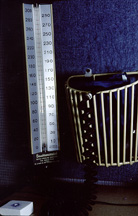
Blood pressure monitors, such as this one, can now be found
on the extinction list at the CC. Some other medical supplies
and equipment, including thermometers, can all contain mercury,
a known health hazard.
CC mercury reduction project in full swing
What do blood pressure monitors, thermometers, and fluorescent
bulbs all have in common? Some types of these items may contain
mercury, a known health hazard when released into the environment.
But the CC has initiated a project to reduce the mercury in the
building, thereby reducing the known risks to humans and the
environment.
"Most exposure to mercury is chronic and cumulative,
and is usually the result of inhalation or ingestion," said
Dr. Michele Evans, CC safety officer. "Typically, employees
may be exposed to contamination when a medical device containing
mercury breaks. These exposures occur by inhalation and although
they are accidental, they are also preventable, and that's what
the mercury reduction project is all about."
Recent national efforts led by the Environmental Protection
Agency and others have shown that the occupational and environmental
costs of using mercury might very well outweigh any other benefits.
"Research has shown that a single drop of mercury spilled
on the floor can result in hazardous air concentrations in indoor
environments," said Evans. The related cost for cleaning
up mercury spills at the CC are often high due to the need for
specially trained staff to clean up the spill, and extra costs
for chemical wastes."Patient care can also be disrupted
in such cases because they would need to be removed from the
area to ensure that they are not harmed," she added.
The CC Safety Committee, along with the Materials Management
Department, Equipment Standardization's Committee, Office of
the Director, and the Division of Safety have all worked together
to reduce the mercury in the CC. One of their first tasks was
to replace equipment that accounted for the most frequent spills.
Whenever possible, new non-mercury medical equipment was purchased,
according to Jerlynn Taylor, nurse consultant in the Materials
Management Department. NIH hazardous waste staff were critical
in removing the old equipment from the patient care areas and
every nursing unit and outpatient clinic was given an in-service
on using the new equipment. "It was a monumental project,"
said Taylor. "But we couldn't have done it without everyone
coming together to get involved."
The group also worked with engineering to remove the mercury-containing
instrumentation controls in the building utility systems, and
is currently looking at more subtle sources of pollution in the
hospital, such as laboratory reagents.
"We may not find acceptable alternatives, but we can
still limit our risks by minimizing the wastes generated and
reinforcing measures to reduce contamination of the work site,"
said Evans. "In keeping with federal mandates, our goal
in the CC is to reduce the use of hazardous materials, including
mercury, by 50 percent by the year 2000."
-by LaTonya Kittles
index
|
|
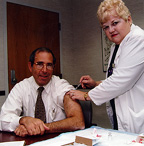 It's not too late It's not too late
Dr. John Gallin, CC director, was among a host of staff to
receive the influenza (flu) vaccine this season. Administering
the shot is Joan Arcilesi, staff nurse with Occupational Medical
Service (OMS). If you haven't yet had your shot, there's still
time. For more information, visit the website at http://www.cc.nih.gov/ccc/98flu/flu.98sced.html,
or call 6-4411.
index
|
|
CC researchers participate in NIH Research Festival
The NIH Research Festival held on Oct. 6-9 drew many to the
Natcher Building to take part in presentations, workshops, and
poster sessions. Among the host of posters were those including
researchers from the Clinical Center.
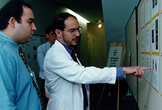
Alberto Goldszal (left) and Dr. Peter Choyke (right) discuss
the CC group's poster, "A Prototype Mouse Phenotype Parameterization
Laboratory."
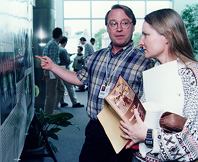
Reviewing their lab chief's poster "A Technical Solution
for an Interactive fMRI Examination: Application to a Physiological
Interview and the Study of Cerebral Physiology," are Kay
Jordan and Henry Bryant with Diagnostic Radiology.
index
|
|
CC Council to explore diversity issues
Not just another committee, the recently assembled CC Workforce
Diversity Advisory Council aspires to become a valuable resource
by promoting recognition and appreciation of diversity within
the Clinical Center.
"This Council promises to be a positive mechanism for
managers to use in monitoring the effects of CC policies, practices,
and procedures on the Clinical Center's diverse workforce,"
said Walter Jones, deputy director for management and operations.
"It will also provide an opportunity for managers and staff
members to improve their awareness and understanding of equality
and workforce diversity."
The Council was developed under the scope of the CC Equal
Employment Opportunity (EEO) Office. Its 13 members represent
a cross-section of the CC population. The Council's plans include
assisting with the design of diversity trainings programs, participating
in special-emphasis observances, and aligning diversity activities
with the CC mission and strategic plan.
Luis Rosario, Medical Records, and LaTonya Kittles, Communications,
co-chair the group. Members are: Harvey McDonald, Diagnostic
Radiology; Clara Chen, Nuclear Medicine; Edna Lowe, Housekeeping
and Fabric Care; Joseph Martin, Human Resources Management; Sandra
Bowles and Sybil Barnaby, Nursing; Sabas Carino, Clinical Pathology;
and Francis Labosco and Nyna Konishi, Materials Management. Non-voting
members are Alisa Peinhardt, Nursing; Carl Lucas, EEO; and Walter
Jones.
index
|
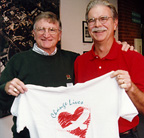
CFC Campaign begins
This year's Combined Federal Campaign (CFC) is off with a
bang and will run through December 4. Keyworkers and coordinators
recently attended a training session hosted by (left) NINR Facilitator
Jack Patterson and (right) Al Rexroad, deputy coordinator of
the CC campaign. Again this year, "It All Comes Back to
You," when you help others. Employees are asked to contribute
to the campaign, which since 1961 has helped to improve the quality
of life for people locally, across the country, and around the
world.
index
|
Rehabilitation Medicine educates many
The Rehabilitation Medicine Department has co-sponsored several
major conferences recently to help educate attendees on areas
pertinent to the field.
"Breast Cancer Rehabilitation for Health Professionals"
was held on October 23, 24, and 25. The session was designed
to increase the knowledge and skills of attendees who are involved
in cancer rehabilitation. The conference was the result of a
collaboration between INOVA Fairfax Hospital and NIH to develop
and implement a comprehensive cancer rehabilitation program for
patients served by INOVA. Speakers included representatives from
INOVA and CC Rehabilitation Medicine.
On Nov. 6-8, the physical therapy section of the Rehabilitation
Medicine Department, along with the American Physical Therapy
Association (APTA), will sponsor "Foot & Ankle Dysfunction:
A Case Study Approach," in the Natcher Conference Center.
The program will utilize several case studies to provide the
clinical and scientific knowledge needed to effectively evaluate
and treat a variety of conditions affecting the foot and ankle.
The physical therapy section, also in collaboration with the
APTA, will host "Compression Bandaging for Edema/Lymphedema
Management," on Nov. 21 in Lipsett Amphitheater. The one-day
seminar is designed for physical therapists and other health
care professionals who need to manage edema/lymphedema in their
clinical practice.
For more information on the Rehabilitation Medicine programs,
call 6-4733.
index
|
|
Balancing the needs of work, family, and community
It's been over a year since Secretary Shalala kicked off the
HHS Quality of Work Life (QWL) Initiative. As well, it was a
year ago that the NIH observed it's first Quality of Work Life
Week, devoted to raising awareness about family and work life
issues.
Once again this year, the NIH will celebrate Quality of Work
Life Week from Nov. 16 through 19. The event will kick off with
a volunteer fair on Monday, Nov. 16 from 10 a.m. to 2 p.m. in
the Visitor Information Center. More than 30 agencies will be
on hand to provide information about their organizations and
volunteer opportunities.
"The purpose of the first NIH Quality of Work Life Week
was to introduce the NIH QWL strategy and to elevate issues that
employees face trying to balance work and personal responsibilities,"
said Marvene Horwitz, chairperson of the NIH Quality of Work
Life Committee. "This year, the observance will not only
feature activities that highlight the achievements of the past
year, but will also give NIH employees a chance to learn how
they can make a difference in their communities."
Additional events for the week include a simulcast of Secretary
Shalala's conference on Family Friendly Work Practices, which
will be held on Tuesday, Nov. 17, from 9 a.m. to 11 a.m. in Building
31, Conference Room 7. On Wednesday, Nov. 18, NIH will host a
reception honoring the most recent recipients of NIH QWL awards,
from 10:30 a.m. to noon in Wilson Hall. The week's events will
culminate with an open house at the NIH Work and Family Life
Center (Building 31 Room B3C15) on Thursday, Nov. 19, from 10
a.m. to 2 p.m.
index
|
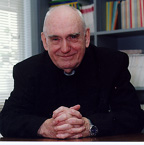
Father Eugene Linehan retires from Spiritual Ministry Department
What started as a temporary assignment has now almost three
decades later turned into a "wonderful experience that words
can't explain."
Rev. Eugene Linehan, Catholic Chaplain in the Spiritual Ministry
Department, recently retired after 26 years of service in the
department.
At the age of 18, Linehan entered the Jesuit seminary. After
15 years of training, he was ordained and began working as a
high school teacher and has also taught at a Jesuit retreat center.
In 1972 he joined the chaplain staff here at the CC.
Linehan said that he was instantly drawn to the CC when he
first entered the building for his temporary assignment. "I
was immediately fascinated by the research taking place here
and the grandness of the facility," he said. But as time
went on, he said that it was his interaction with the staff and
patients that taught him many life lessons and earned his admiration.
"Daily mass has always given me a tremendous amount of
strength," said Linehan. "We are praying for real things
and prayer comes alive because of the needs of patients."
He credits the wonderful friends that he has made among CC
patients and staff for his happiness here. "It is great
to have friends among people who are different faiths,"
he said. Among those is Rabbi Joseph Levine, Jewish Chaplain
in Spiritual Ministry, who calls Linehan, "one of the most
loving men in the world." Rabbi Levine credits Linehan with
having the ability to love people as individuals and not because
of their religious beliefs. "Father Linehan has no denominational
boundaries but he is respectful of all beliefs," he said.
"We all have cultural fences and he has the ability to transcend
them."
Among the most vivid experiences that Linehan has had is the
daily opportunity to see the enormous amount of strength in pediatric
patients being treated here. He said that one of his fondest
memories was when one young patient was discussing his pending
death and said, "I have lost the battle, but I've won the
war."
"These children and patients here who can accept illness
and death with complete serenity are a blessing," he said.
No doubt, Father Linehan has helped them reach that point.
-by LaTonya Kittles
index
|
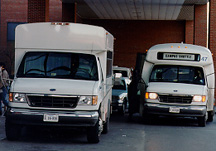
As construction on the new Mark O. Hatfield Clinical Research
Center changes the course of the area surrounding the CC, employees
might find campus shuttles to be more and more convenient.
NIH gets around: Finding your way around campus
Starting later this month, NIHers riding the shuttle buses
will notice some changes that should improve the way they get
around the campus.
For one thing, the bus routes will be more easily identified
through color coding. Also, two major hubs at Building 31 and
the new Building 10 South Entry will serve not only the campus
route, but also all off-campus shuttles. In addition, a new stop
on Center Drive will serve as a minor hub providing additional
service to the Natcher Building and the Library of Medicine.
The Medical Center Metro stop will be the second minor hub with
direct routes to Building 10 and Building 31, in addition to
the regular campus shuttle. All shuttles will run in one direction
throughout the day eliminating much of the current confusion.
And finally, new signs at all bus stops will have clearly posted
route maps and stop schedules.
The proposed changes are prompted by the upcoming opening
of the new South Entry to Building 10. But revisiting the current
NIH shuttle system has been a top priority for the Office of
Research Services (ORS) for some time now.
"We always felt that the shuttle buses are an integral
part of the NIH Transportation Management Plan," says Stella
Serras Fiotes, master planner with ORS Facilities Planning and
Programming Branch. Fiotes has been collecting information and
considering improvements since the parking and transportation
survey, which was conducted late last year.
With the recent formal transfer of the shuttle buses to ORS,
changes are being coordinated directly with other ongoing parking
and transportation initiatives. Further reductions in the campus
parking supply will increase employee reliance on the NIH shuttle
buses to access outlying campus lots, off-campus satellite lots,
and the Metro station. The closure of the north entry to Building
10 and the opening of the South Entry will result in a total
re-orientation of pedestrian, vehicular and bus traffic to the
Clinical Center. With over 6,000 employees, and numerous visitors
coming to this building, it became apparent that the shuttle
buses would not only need to service the new South Entry but
also provide more options for accessing the rest of the campus.
The concept underlying the proposal is simple. The entire
NIH shuttle system is viewed as one integrated network of routes.
Off-campus routes are linked at the hubs to the campus shuttle,
which will continue to provide "loop" service around
the entire campus. Riders waiting at the shuttle hubs will have
more than one option to travel to any of the other hubs. By coordinating
routes and stops, Fiotes hopes to take better advantage of the
fleet of over 20 shuttle buses serving NIH.
index
|
|
Maryland Ravens hoop it up on the 14th floor
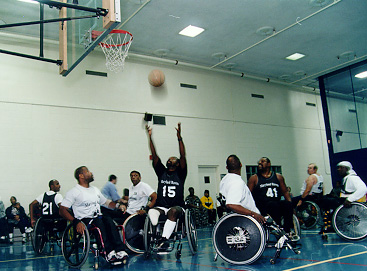
During activities for Disability Awareness month in October,
members of the Maryland Ravens wheelchair basketball team challenged
NIH employees to a game. The program, "Opening Doors to
Disability," provided an opportunity to increase awareness
of disability.
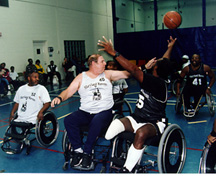
Basketball isn't the only eye-opening activity conducted by
the group. They have given lectures at schools and sites throughout
the community for the last 25 years.
index
|
|
News briefs
Celebrate Escort Services
Join the Outpatient Department's Patient Escort Service in
celebrating patient escort services Nov. 2-6 from 9 a.m. to 2
p.m. outside the special events office, 1C174. They will sponsor
their fourth annual raffle to benefit the Patient Emergency Fund,
and the winner will receive exclusive transport services for
the department of their choice. Tickets can be purchased from
a member of the patient escort team, or outside the second floor
and B1-level cafeterias on Nov. 2-6.
Benefit concert
The Performing Arts Ensemble will present "Holiday in
Oz" on Dec. 12 at 7:30 p.m. in Masur Auditorium. This sixth
annual benefit concert will support the Friends of the Clinical
Center. The event will include door prizes and a cameo appearance
by Santa Claus. Admission is $8 for adults, and $4 for children
ages 12 and under. Sign language interpreters will be available.
For tickets, call 4-5596.
Medicine for the Public continues
The 1998 Medicine for the Public lectures continue this month.
NCI's Dr. Marston Linehan will present "Kidney Cancer: Understanding
How Genes Impact Cancer" on Nov. 10, and Dr. Harold Slavkin,
NIDR, will present "A Smile for a Lifetime" on Nov.
17. All lectures begin at 7 p.m. in Masur Auditorium. For more
information call 6-2563.
Learn to retire
Are you interested in learning more about retirement benefits
available within the Federal service? Attend "Mid-Career
Retirement Planning," on Dec. 2-3 from 9 a.m. to 4 p.m.
in room 3E01 at 6100 Executive Boulevard. To register, call the
CC education and training section at 6-1618.
Clinical Pathology Auction
For 26 years, the Clinical Pathology Department has participated
in a holiday fundraiser to benefit the Patient Emergency Fund
and the Friends of the Clinical Center. Join the group in this
year's activities by volunteering your services or donating items
to the white elephant sale and silent auction. The event will
take place on Dec. 4 from 9 a.m. to 2 p.m. in room 2C310. To
make donations, call Sallie Seymour at 6-3386, or Norma Ruschell
at 6-4473.
Blood urgently needed
The CC Department of Transfusion Medicine is in urgent need
of type O blood. If you are a donor of this type, please donate
today. Visit the blood bank in room 1C713B, or call 6-1048 for
more information.
Use it or lose it
Since the 1998 leave year ends on January 2, 1999, all "use
or lose" leave must be scheduled or rescheduled in writing
by Nov. 21. For more information contact personnel at 6-6219.
index
Editor:
LaTonya Kittles
Clinical Center News
, 6100 Executive Blvd., Suite
3C01, MSC 7511, National Institutes of Health, Bethesda, Maryland
20892-7511. (301) 496-2563. Fax: 402-2984. Published monthly
for CC employees by the Office of Clinical Center Communications,
Colleen Henrichsen, chief. News, articles ideas, calendar events,
letters, and photographs are welcome. Deadline for submission
is the second Monday of each month.
top
| cc
home page | nih home
page |
|
|

